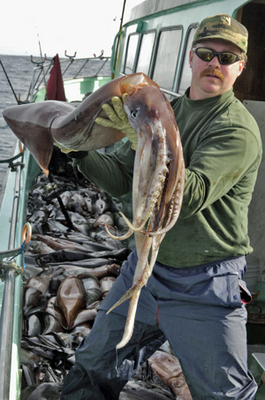Oxygen-starved waters are expanding in the Pacific and Atlantic as ocean temperatures increase with global warming, threatening fisheries and other marine life, a study published today concludes.
Most of these zones remain hundreds of feet below the surface, but they are beginning to spill onto the relatively shallow continental shelf off the coast of California and are nearing the surface off Peru, driving away fish from commercially important fishing grounds, researchers have found.

|
| ©Erhardt Krause / Sacramento Be |
| NEAR SAN FRANCISCO: Scientists think that oxygen-poor zones may explain the Pacific Ocean invasion of jumbo, ƒsor Humboldt, squid. Fisherman Steve Consulo holds one. |
The low-oxygen, or hypoxic, zones may also be connected to the Pacific coast invasion of the Humboldt, or jumbo, squid. These voracious predators, which can grow 6 feet long, appear to be taking advantage of their tolerance for oxygen-poor waters to escape predators and devour local fish, another team of scientists theorizes.
Researchers believe these phenomena are linked to subsurface layers of hypoxic water in the tropical Pacific and Atlantic oceans that have been thickening over the last 50 years, according to the analysis published today in the journal Science.
The study, led by Lothar Stramma at the University of Kiel in Germany, warns that the spread of hypoxic waters that suffocate marine life is consistent with climate models forecasting what would happen as greenhouse gases accumulate in the atmosphere.
The trend, the study points out, eerily echoes a scenario that unfolded about 250 million years ago, when 95% of life on Earth went extinct after heat-trapping carbon dioxide spewing from volcanoes warmed the planet and the oceans became stripped of oxygen.
"If you warm waters, they hold much less oxygen," said coauthor Gregory C. Johnson, an oceanographer with the federal Pacific Marine Environmental Laboratory in Seattle. "That's the same as a bottle of soda water. If you open it warm, it'll fizz all over the place. If you open it cold, it will slowly fizz out as it warms."
More importantly, Johnson said, the lighter warm water creates a cap over the colder depths, making it less likely that oxygen-enriched surface water will mix with colder water. Other biogeochemical processes also rob oxygen from deeper waters, such as the decomposition and re-mineralization of dead plankton as it settles to the seafloor.
These vast low-oxygen zones that stretch far out to sea differ from the "dead zones" at the mouth of the Mississippi River and in near-shore waters around the world. These localized low-oxygen waters typically form after fertilizer-rich river discharges produce thick blooms of algae that suck the oxygen out of water after they die and decompose.
Today's study analyzed decades of oxygen measurements in six spots in the deeper ocean. In all but the Indian Ocean study area, the team found significant expansion of water inhospitable to most marine life, said Janet Sprintall, a scientist at the Scripps Institution of Oceanography in La Jolla.
In the tropical Pacific off Peru, the band of low-oxygen water increased in thickness from 460 yards to about 670 yards over the past 42 years and moved closer to the surface. In the Atlantic south of Africa, the suffocating layer grew from 400 yards thick to 750 yards thick over the last 46 years.
"Most fish and other marine animals have to move or die," Sprintall said. "They cannot live in these low-oxygen conditions."
The findings impressed Steven J. Bograd, an oceanographer with the National Oceanic and Atmospheric Administration in Pacific Grove, Calif. Bograd, who was not part of the study, said it reflected the dropping oxygen levels that he and other scientists have found off California.
These low-oxygen waters are swept from the tropical Pacific by an unseen midwater "undercurrent" that snakes up the coast, at the edge of the continental shelf.
Some of that oxygen-deprived water has been edging onto the shelf and into key fishing grounds, according to Bograd's study, which has been accepted for publication in Geophysical Research Letters. Plunging oxygen levels have been detected off British Columbia.
Francisco Chavez, a study coauthor and senior scientist at the Monterey Bay Aquarium Research Institute in Moss Landing, said that California can look to Peru for potential problems ahead. Peruvian authorities have struggled for a decade over a commercial fish called hake that is being squeezed between overfishing and oxygen-starved waters.
Northern California's hake fishery has not seen any signs of being crowded by oxygen-starved waters, said federal fisheries biologist John Field. These fish tend to migrate along the same current of low-oxygen water that is being drawn up the coast from the tropical Pacific.
"At some point, it's going to push them up to the surface," he said.
Humboldt squid apparently have been eating hake off California, just as they do off Peru, Field said. Some scientists believe the squid have expanded their range due to over-exploiting of sharks and other predators.
But squid expert William Gilly of Stanford's Hopkins Marine Station theorizes that this expanding minimum-oxygen zone gives them a convenient cover.
"They are hidden in this safety zone where the big predators cannot get them," Gilly said. "The squid are just hanging down there, emerging from the curtain to suck down all of the fish."



Reader Comments
to our Newsletter